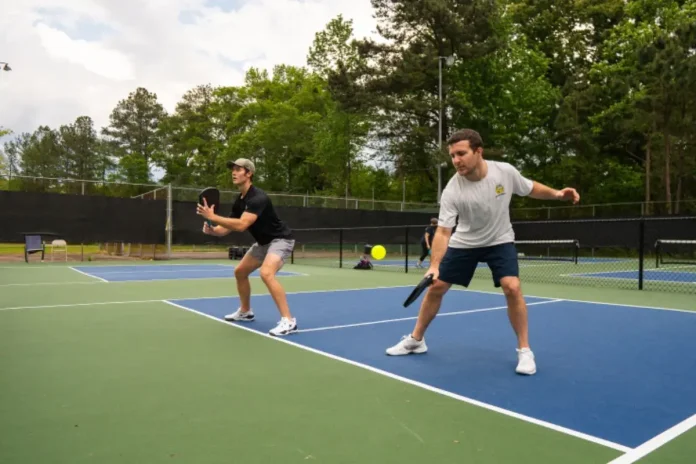9-Zone Airspace Model Pickleball Strategy: A new strategy called the 9-Zone Airspace Model is helping pickleball players focus not just on where the ball lands, but on how it travels through the air above the net. This method teaches players to control air zones to attack, reset, and defend more effectively on the court.
Thinking in 3D, Not Just on the Court
Most players aim at pickleball court spots—like deep corners or feet. But high-level players think in 3D, watching how the ball moves over the net. Controlling this “airspace” helps them hit smarter shots and react faster.
“Coach, trust me—this is where control meets chaos,” said the article’s author.
Understanding which air zone a shot enters helps players:
- Know if a ball can be attacked
- Adjust paddle angle
- Prepare footwork for resets
- Decide when to hit or let the ball drop
How the 9-Zone Airspace Model Works
The area above the net is split into 9 zones using three vertical levels and three horizontal lanes. Picture a tic-tac-toe board floating above the net.
Left to Right: Opponent’s forehand → center → backhand
Top to Bottom (Vertical Layers):
- High (Z7–Z9): Above shoulder—attack zones
- Mid (Z4–Z6): Chest-high—tempo control
- Low (Z1–Z3): Just above net—reset zones
Each zone gives different results based on how the opponent reacts.
Zone Breakdown and Tactics
Zones 7–9 (High Air Zones):
- Z7 (Forehand Shoulder High): Speed-ups need spin. “Forehand flicks are deadly.”
- Z8 (Center High): Great for surprise attacks. “Dead zone for your opponent.”
- Z9 (Backhand High): Best spot for off-speed shots. “Even pros struggle with backhand high counters.”
Zones 4–6 (Mid Air Zones):
- Z4 (Forehand Mid): Use for tempo dinks. “You may draw a pop-up.”
- Z5 (Center Mid): Safer resets—but “vulnerable if floated.”
- Z6 (Backhand Mid): Great for causing mistakes. “May force a mis-hit dink.”
Tip: Dink to Z4 to pull opponents in, then strike to Z6.
Zones 1–3 (Low Air Zones):
- Z1 (Forehand Low): Ideal for soft resets. “Practically unattackable.”
- Z2 (Center Tape): Easiest spot to control chaos. “The safest and softest point.”
- Z3 (Backhand Low): Hard to attack from. “Roll it in here when you want to reset without pace.”
Practice Tips for Air Control
Players can train by standing at the kitchen line and calling out their zone before each shot—for example, “Z3!” This builds focus and helps players learn where the ball should pass in the air.
In one example, a player dinks three times to Z4, drawing their opponent forward. Then they attack into Z8. “They flinch, you finish.”
Match Your Zones to Opponent Type
Different opponents respond better or worse depending on where the ball enters the air:
- Against fast hitters: Stay in Z1–Z3 to make attacks difficult.
- Against soft players: Target Z6 and Z8 to test backhand reactions.
- Against tall or aggressive players: Avoid Z7 and trick them using Z4, then strike in Z5 or Z9.
Why It Matters
Most players only look at where the ball lands. But smart players use the space over the net to control the pace, force errors, and open attack windows.
“The best players aren’t just aiming at feet or sidelines,” said the author. “They’re manipulating airspace to control tempo, reactions, and decisions.”
News in Brief: 9-Zone Airspace Model Pickleball Strategy
A new 9-Zone Airspace Model is teaching pickleball players to aim through the air, not just at the court. By dividing the space above the net into nine zones, players learn to control tempo, force mistakes, and attack smarter. This model helps all players improve decision-making at the net.
ALSO READ: Coach Tony Roig Teaches Pickleball Players Over 50 How to Move Safely and Smartly on the Court

